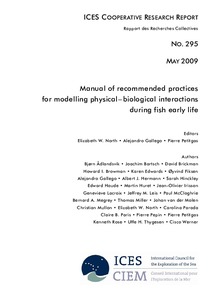| dc.contributor.editor | North, Elizabeth W. | |
| dc.contributor.editor | Gallego, Alejandro | |
| dc.contributor.editor | Petitgas, Pierre | |
| dc.date.accessioned | 2019-01-04T17:52:14Z | |
| dc.date.available | 2019-01-04T17:52:14Z | |
| dc.date.issued | 2009 | |
| dc.identifier.citation | North, E.W.; Gallego, A. and Petitgas, P. (eds) (2009) Manual of recommended practices for modelling physical–biological
interactions during fish early life. ICES Cooperative Research Report, No. 295, 112pp. DOI: http://dx.doi.org/10.25607/OBP-183 | en_US |
| dc.identifier.issn | ISSN 1017 – 6195 | |
| dc.identifier.uri | http://hdl.handle.net/11329/624 | |
| dc.identifier.uri | http://dx.doi.org/10.25607/OBP-183 | |
| dc.description.abstract | The
objectives
of
this
manual
of
recommended
practices(MRP)
are
to
summarize
appropriate
methods
for
modelling
physical–biological
interactions
during
the
early
life
of
fish,
to
recommend
modelling
techniques
in
the
context
of
specific
applications,
and
to
identify
gaps
in
knowledge.
This
manual
is
intended
to
provide
a
reference
for
early‐career
modellers
who
are
interested
in
applying
numerical
models
to
fish
early
life
and
who
would
benefit
from
a
summary
of
recommended
practices
for
coupled
biological–physical
models
that
incorporate
predictions
from
three‐dimensional
circulation
models
to
determine
the
transit
of
fish
eggs,
larvae,
and
juveniles
from
spawning
to
nursery
areas.
For
current
practitioners
of
numerical
modelling
in
fish
early
life,
the
manual
provides
updates
on
latest
techniques
and
areas
in
need
of
further
research.
Although
the
manual
focuses
on
finfish,
many
of
the
summarized
modelling
techniques
and
recommended
practices
apply
to
modelling
planktonic
organisms,
including
zooplankton
and
other
meroplankton
(e.g.
molluscs
and
crustaceans).
It
is
important
to
recognize
that
“best”
modelling
practices
depend
upon
the
objective
of
the
modelling
exercise.
In
other
words,
no
single
model
is
appropriate
to
all
applications.
Instead,
model
formulations
are
situation-specific.
Because
methodologies
depend
upon
the
goal
of
the
endeavour,
this
manual
includes
an
overview
of
basic
components
of
fish
early
life
models
and
presents
recommendations
in
the
context
of
three
specific
applications:
adaptive
sampling,
connectivity,
and
recruitment
predic
‐
tion.
The
first
three
sections
(Section 1– Hydrodynamic
models,
Section 2 – Particle
tracking,
and
Section 3 - Biological
processes)
summarize
methodologies
that
are
important
components
of
three‐dimensional
models
of
the
early
life
of
fish.
The
next
three
sections
(Section 4 – Application 1:
adaptive
sampling,
Section 5 – Application
2:
connectivity,
and
Section 6 –
Application
3:
recruitment
prediction)
discuss
the
application
of
selected
methodologies
to
specific
issues
that
are
commonly
addressed
with
these
models.
The
final
section
summarizes
the
information
gaps
and
research
needs
identified
throughout
the
manual.
This
MRP
grew
out
of
participant
discussions
at
the
“Workshop
on
Advancements
in
Modelling
Physical–Biological
Interactions
in
Fish
Early
Life
History:
Recommended
Practices
and
Future
Directions”
(WKAMF)
held
on
3–5 April
2006
in
Nantes,
France.
This
manual
does
not
contain
an
exhaustive
review
of
all
approaches
to
modelling
the
early
life
of
fish.
Instead,
it
is
intended
to
be
a
general
reference
for
fish
early
life
modelling
that
includes
citations
that
will
direct
readers
to
in‐depth
treatments
of
specific
topics.
In
addition,
it
should
be
noted
that
this
document
does
not
represent
the
consensus
recommendations
of
all
authors.
Each
section
was
written
separately.
In
some
cases,
differences
in
recommendations
and
perspectives
exist.
These
apparent
contradictions
may
stem
from
dissimilarity
in
the
time
or
space
scale
of
the
models
used
by
the
authors
or
the
ecosystem
in
which
the
authors
are
most
experienced
(e.g.
temperate
vs.
tropical).
The
issues
on
which
recommendations
or
perspective
diverge
are
those
that
remain
an
active
area
of
research.
This
manual
is
a
“living”
document:
future
revisions
and
updates
are
expected
as
our
understanding
and
methods
evolve. | en_US |
| dc.language.iso | en | en_US |
| dc.publisher | International Council for the Exploration of the Sea (ICES) | en_US |
| dc.relation.ispartofseries | ICES Cooperative Research Report;;295 | |
| dc.rights | Attribution-NonCommercial-ShareAlike 4.0 | |
| dc.rights.uri | http://creativecommons.org/licenses/by-nc-sa/4.0 | * |
| dc.subject.other | Biological-physical modelling | en_US |
| dc.title | Manual of recommended practices for modelling physical – biological interactions during fish early life. | en_US |
| dc.type | Report | en_US |
| dc.description.status | Published | en_US |
| dc.format.pages | 112pp. | en_US |
| dc.description.notes | Authors:
Bjørn Ådlandsvik • Joachi
m Bartsch • David Brickman
Howard I. Browman • Karen Edwards • Øyvind Fiksen
Alejandro Gallego • Albert J. Hermann • Sarah Hinckley
Edward Houde • Ma
rtin Huret • Jean-Olivier Irisson
Geneviève Lacroix • Jeffrey
M. Leis • Paul McCloghrie
Bernard A. Megrey • Thomas
Miller • Johan
van der Molen
Christian Mullon • Elizabeth
W. North • Carolina Parada
Claire B. Paris • Pierre
Pepin • Pierre Petitgas
Kenneth Rose • Uffe H. Thygesen • Cisco Werner | en_US |
| dc.description.refereed | Refereed | en_US |
| dc.publisher.place | Copenhagen, Denmark | en_US |
| dc.subject.parameterDiscipline | Parameter Discipline::Biological oceanography::Fish | en_US |
| dc.description.currentstatus | Current | en_US |
| dc.description.sdg | 14.4 | en_US |
| dc.description.sdg | 14.A | en_US |
| dc.description.eov | Fish abundance and distribution | en_US |
| dc.description.bptype | Manual | en_US |
| dc.description.bptype | Guide | en_US |
| obps.contact.contactemail | library@ices.dk | |
| obps.resourceurl.publisher | http://ices.dk/publications/library/Pages/default.aspx | en_US |
 Repository of community practices in Ocean Research, Applications and Data/Information Management
Repository of community practices in Ocean Research, Applications and Data/Information Management

